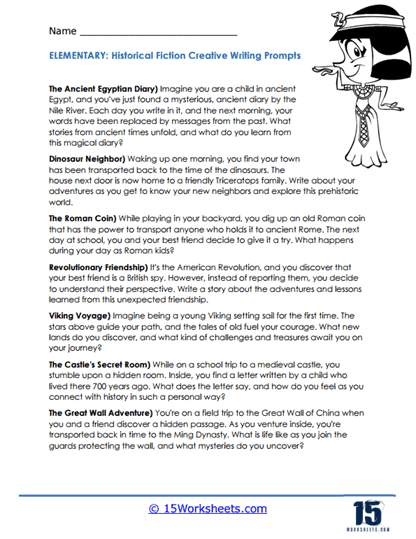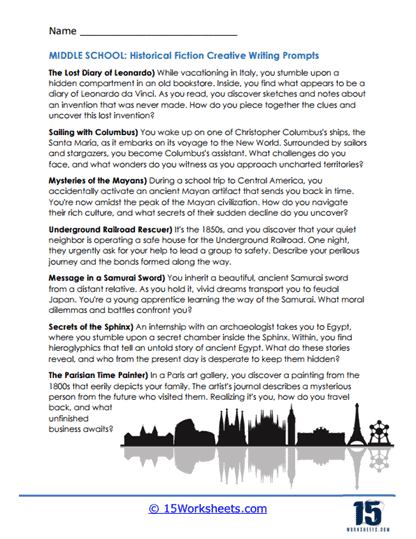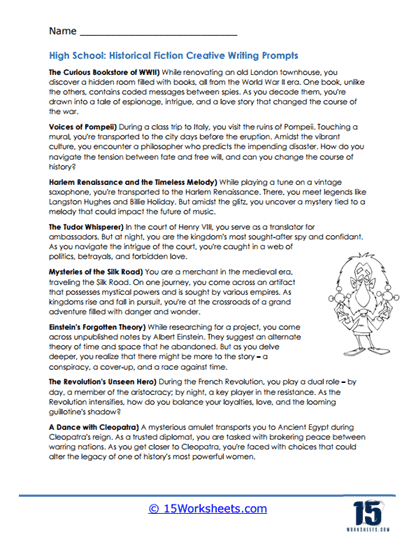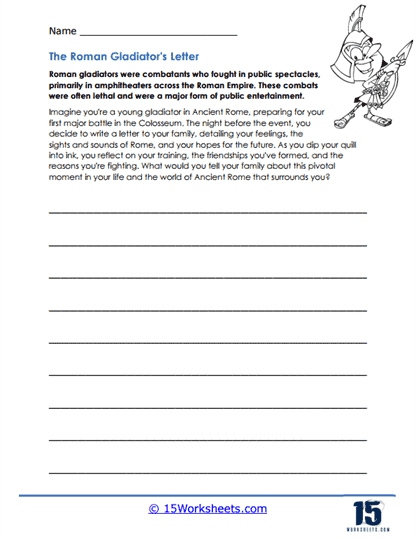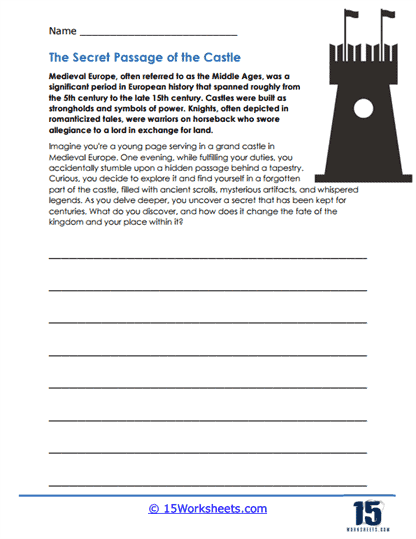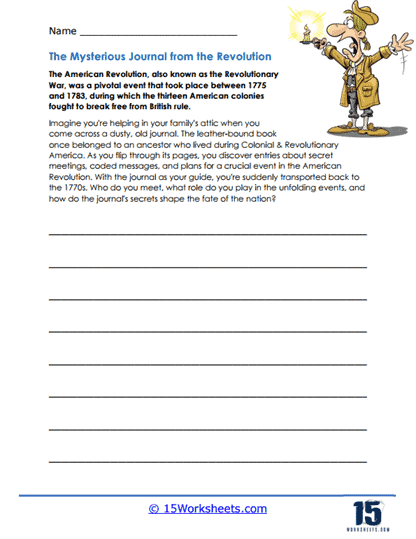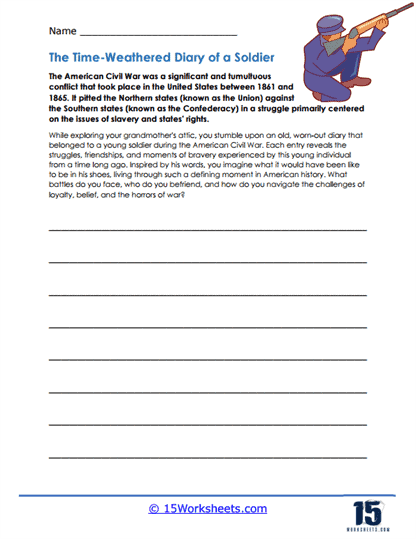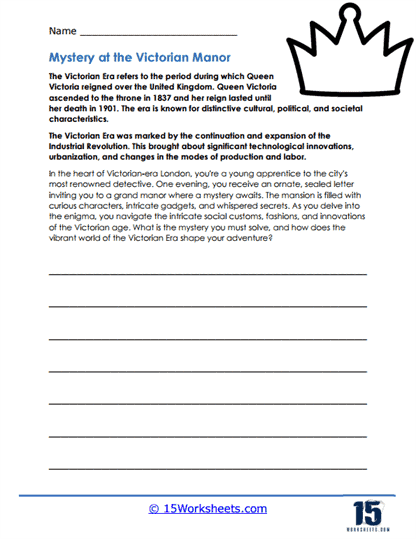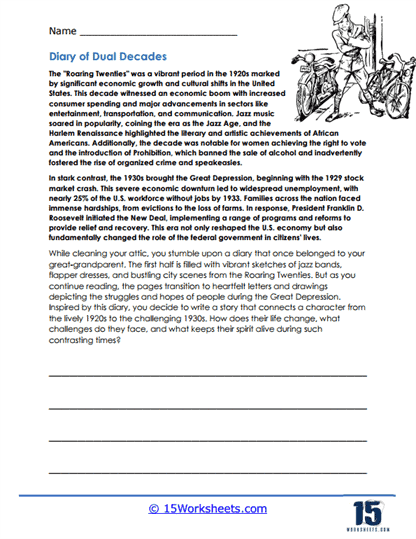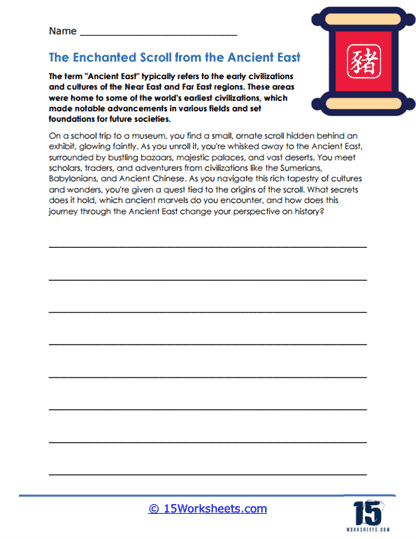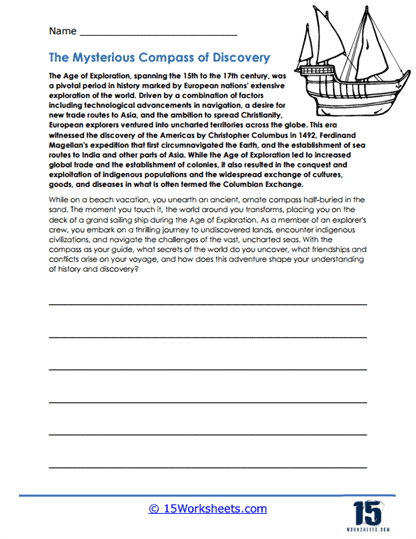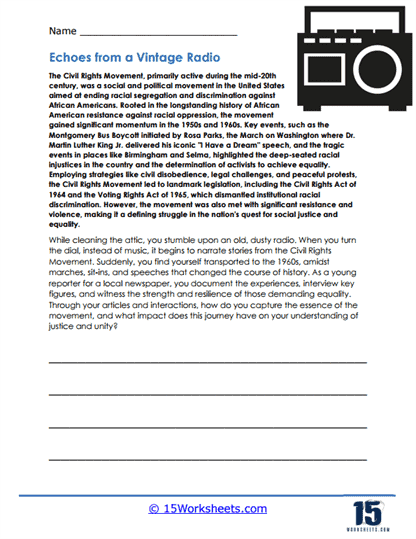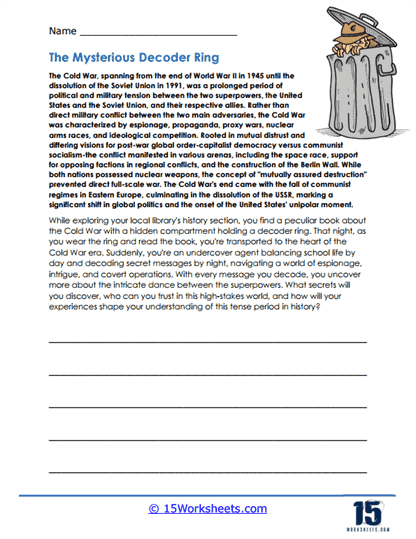Historical Fiction Worksheets
About These 15 Worksheets
Writing is a fundamental skill, closely interwoven with the way we communicate, think, and express ourselves. Within the broad spectrum of writing genres, historical fiction stands out as a unique amalgamation of factual history and imaginative creativity. This is a domain where the stories of the past blend with the ingenuity of the writer. But how do budding writers delve into this intricate realm? Enter – Historical Fiction Writing Prompts.
Historical Fiction Writing Prompts are starting points or ideas rooted in actual historical events, personalities, or epochs, designed to inspire writers to craft stories that weave fictional narratives around factual history. These prompts can be simple like, “Imagine you’re a soldier during the American Civil War…” or more detailed, giving intricate settings, character backgrounds, or situational contexts. Their primary aim is to provide a launchpad from which writers can leap into the deep waters of historical narratives.
Catalysts for Creativity
Historical fiction acts as a bridge between the factual world of history books and the vibrant realm of storytelling. It introduces readers and writers to diverse cultures, epochs, and situations, enabling them to travel through time and see the world through different lenses. It also can help students unleash a higher level of creativity that they have not previously realized.
Unleashing Imagination – One of the primary ways these prompts foster creativity is by encouraging students to take a factual base and expand it with their imagination. While the historical backdrop provides a solid foundation, the gaps in history become areas where students can exercise their creativity. How would a peasant react during the French Revolution? What were the personal struggles of a samurai during feudal Japan? By seeking answers to these questions, students paint vivid narratives over the canvas of history.
Exploring Perspectives – History is often a tale told by victors. Historical fiction prompts allow students to explore untold stories and lesser-known perspectives. They can pen down tales from the viewpoint of the marginalized, the silent spectators, or even the antagonists. Such exercises challenge them to think out of the box, enriching their creative faculties.
Blurring the Lines – The beauty of historical fiction lies in its delicate balance between fact and fantasy. Through prompts, students learn the art of blending reality with imagination seamlessly. This blurring of lines pushes them to innovate, creating stories that, while grounded in reality, soar in the skies of fiction.
Improving Communication in Writing
Enhanced Research Skills – The foundation of historical fiction is accurate historical knowledge. Thus, these prompts indirectly push students to research. They’ll delve into books, articles, and archives to get their facts straight. This research not only broadens their knowledge but also hones their ability to gather, process, and present information effectively.
Building Empathy – Writing about past events and diverse characters nurtures empathy. By placing themselves in the shoes of characters from different eras or backgrounds, students learn to understand and communicate varied emotions, challenges, and experiences. This emotional depth and understanding reflect in their writing, making it more poignant and relatable.
Articulating Complex Ideas – The challenge in historical fiction is to convey complex historical events and societal dynamics in an engaging manner. As students grapple with this challenge, they become adept at breaking down complicated ideas and communicating them in an accessible and engaging manner.
Vocabulary and Language Development – Period-specific language, attire, customs, and settings require a rich vocabulary and a certain finesse in writing. Crafting stories around these prompts aids students in expanding their lexicon and refining their language skills.
Example Prompts and Responses
Prompt 1 – The Lost City of Atlantis
In the annals of history, the lost city of Atlantis has always been shrouded in mystery. Legend says that this advanced civilization existed in prehistoric times and vanished in a single day and night of catastrophe. Imagine you are an Atlantean scholar, just days before the city’s fabled destruction. Detail the last piece of research you were working on and the sudden signs that made you realize that the end of Atlantis was near.
Prompt 1 Response
As Lyria, the lead Atlantean scholar of crystal energy, I had always been engrossed in harnessing the city’s vibrational frequencies. These frequencies were said to be the source of our city’s unmatched progress and prosperity. But, days before the cataclysm, my instruments started registering erratic energy pulses from the city’s core. Late one evening, while examining a crystal shard, I noticed an unusual crimson hue that had never appeared before. In our ancient manuscripts, there was a solitary reference to this occurrence – it was an omen, signaling the city’s imminent doom.
Prompt 2 – The Era of Renaissance Italy
Renaissance Italy was a melting pot of art, science, politics, and innovation. The streets of Florence bustled with artists like Leonardo da Vinci and merchants vying for influence. Imagine you are a young apprentice to a less-known sculptor in Florence, and you stumble upon a secret society that believes in the intersection of magic and art. Describe your first encounter with this society and the mystic art piece that they believe can change the course of history.
Prompt 2 Response
Under Master Antonio’s guidance, I’d learnt to carve even the hardest of marbles with ease. However, one evening, after retrieving a rare stone for a commissioned piece from a concealed storeroom, I found a hidden passage. Following it led me to a dimly lit chamber where hooded figures circled an ethereal sculpture of a phoenix, its eyes shimmering with an otherworldly glow. Whispered voices spoke of the “Art of Creation” — a magical practice believed to breathe life into art. This phoenix, they said, once complete, would herald a new age, altering the path of Renaissance itself.
Prompt 3 – The Mughal Empire in India
The Mughal Empire, with its majestic monuments and tales of love and war, left an indelible mark on India. Emperor Shah Jahan, heartbroken after the death of his beloved wife Mumtaz Mahal, decided to build the Taj Mahal as an ode to their love. But imagine there’s a twist – Shah Jahan receives a letter, purportedly from the future, detailing the decline of the Mughal Empire after his reign. Describe the Emperor’s reaction and his ensuing conversation with his trusted advisor about the contents of this mysterious letter.
Prompt 3 Response
Emperor Shah Jahan, while deeply engrossed in the plans for the Taj Mahal, was handed a peculiarly crafted envelope sealed with an emblem he did not recognize. The letter inside spoke of events beyond his time — the fall of the Mughal Empire, the British invasion, and the subsequent colonization of India. Disbelief clouded his eyes, yet a lingering doubt gnawed at him. Summoning his closest advisor, Feroze, he read the letter aloud. Feroze, ever the pragmatist, cautioned skepticism but also saw it as a chance to strengthen the empire’s defenses. Their conversation, deep into the night, revolved around legacy, fate, and the malleability of time.

